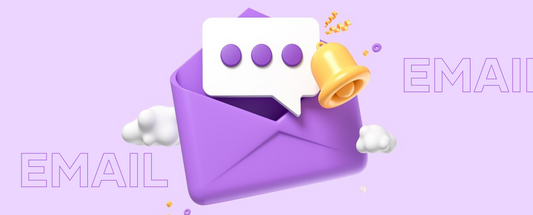Shopify Email Templates: A Comprehensive Guide

Once upon a time, in a world of brick and mortar, communication between a business and its customers was mostly face-to-face. Fast forward to today, where online shopping is as ubiquitous as the air we breathe, email has become one of the most powerful tools in our digital arsenal.
Welcome to the magical realm of Shopify, where your email templates are more than just words. They are your brand's voice, your customer's guide, and your business's success story all rolled into one. Let's embark on a journey to uncover the secrets of these templates, ensuring you not only reach your customers but also captivate them.
The Importance of Email Templates in Shopify

In the ever-evolving digital landscape, where the competition is fierce and attention spans are short, your brand's ability to engage with customers is paramount. Email templates in Shopify serve as the bridge between your business and its audience, playing a pivotal role in your success story. Let's explore the significance of these templates in detail:
Personalized Touch:
Imagine walking into a small, local boutique where the owner knows your name, remembers your preferences, and recommends products tailored just for you. That's the kind of personal touch email templates can bring to your online store.
Personalization is not just about addressing customers by their first names; it's about crafting emails that resonate with their interests, past purchases, and browsing behavior.
A well-designed template allows you to incorporate these personalization elements seamlessly, making each email feel like a one-on-one conversation rather than a generic message.
Consistency:
In the vast digital world, brand recognition is essential. Customers should be able to recognize your emails at a glance, just as they would recognize your physical storefront.
Email templates provide a consistent visual and tonal identity for your brand. Whether a customer receives an order confirmation, a promotional offer, or a newsletter, the look and feel of your emails should remain consistent.
Consistency breeds trust. When customers see familiar colors, fonts, and messaging, they are more likely to engage and trust your brand.
Efficiency:
Time is a precious resource for any business owner. Crafting unique emails for every communication can be time-consuming and may lead to inconsistencies.
Email templates streamline your communication process. Instead of starting from scratch every time, you can use a pre-designed template as a foundation and make necessary adjustments.
This efficiency not only saves time but also ensures that your emails are always aligned with your brand's style and voice.
Measurable Results:
In the digital age, every action can be tracked and measured. Email marketing is no exception. Email templates, when used in conjunction with analytics tools, allow you to measure the performance of your email campaigns.
You can track open rates, click-through rates, conversion rates, and more. This data provides valuable insights into what works and what doesn't, enabling you to refine your email strategies for better results.
With the right data, you can make informed decisions to optimize your email content, design, and timing.
Elements of a Successful Email Template
In the storytelling of email marketing, your email template serves as the canvas on which you paint your message. Just as any compelling story has key elements like characters, settings, and plots, a successful email template comprises essential components that work harmoniously to engage your audience and drive desired actions. Here's a detailed breakdown:
Headline: The Captivating Title
Just like a book's title grabs your attention, the headline of your email should entice the recipient to open and read it. It's the first impression and should be clear, concise, and relevant to the email's content.
A captivating headline can be the difference between your email being opened and it ending up in the dreaded "spam" folder. Make it compelling and aligned with your message.
Imagery: Visual Storytelling
A picture is worth a thousand words. High-quality images can convey emotions, showcase products, and add depth to your email's narrative.
Ensure that your images are relevant to the content and the message you want to convey. They should be clear, properly sized, and responsive to different devices.
Alt text for images is essential for accessibility and can also serve as a backup in case the images don't load, ensuring your message still makes sense.
Body: Weaving the Narrative
The body of your email is where you tell your story, whether it's about a new product, a special offer, or an informative newsletter.
Keep the content concise and scannable. Use short paragraphs, bullet points, and subheadings to break up the text and make it easy to read.
The content should be engaging and relevant to the recipient. Address their pain points, needs, or interests to capture their attention.
Call to Action (CTA): The Climax
Every great story has a climax, and your email should too. The CTA is where you guide your readers towards the desired action, whether it's making a purchase, signing up for a newsletter, or exploring your website.
Make your CTA buttons stand out visually with contrasting colors and clear, action-oriented text. Use persuasive language that encourages immediate action.
Ensure that the CTA button is mobile-friendly and functions seamlessly on all devices.
Contact Information and Unsubscribe Option: Trust and Compliance
Building trust is crucial in email marketing. Include your contact information, including a physical address, to show transparency and credibility.
Include a clear and easy-to-find option for recipients to unsubscribe from your emails. This not only keeps you compliant with email marketing regulations but also demonstrates respect for the recipient's preferences.
Footer: The Closing Chapter
The email's footer is like the closing chapter of a book, wrapping up the story. It typically includes links to your social media profiles, legal disclaimers, and privacy policies.
Ensure that your footer is well-organized and provides recipients with valuable information and options for further engagement.
Customising Your Shopify Email Templates

In the world of Shopify, flexibility and customization are key to ensuring that your email templates align perfectly with your brand's identity and resonate with your audience. Here's a comprehensive guide on how to tailor-make your Shopify email templates:
Theme Settings: The Canvas of Your Email Template
Shopify offers a wide array of themes, each with its own style and layout options. Start by selecting a theme that closely matches your brand's aesthetics.
Dive into the theme settings. Most Shopify themes allow you to customize colors, fonts, and layouts. Use this feature to align your email templates with your brand's unique look and feel.
Customize the header and footer of your email templates to include your logo, brand colors, and social media links for consistent branding.
Edit Language: Crafting Your Brand's Voice
While Shopify provides default wording for various email templates, it's essential to edit this language to match your brand's tone and voice.
Use language that resonates with your target audience. Whether your brand is playful, formal, or informative, your email templates should reflect this personality.
Review and edit pre-written content like order confirmations, shipping notifications, and thank-you messages to ensure they convey your brand's message effectively.
Add Personal Touches: Creating Unique Experiences
One of the advantages of using Shopify is its ability to integrate customer data into your email templates.
Utilize customer information such as their first name or past purchase history to create personalized email templates. A simple greeting using the recipient's name can go a long way in making the email feel special.
Incorporate product recommendations based on the customer's browsing or purchase history, enhancing the personalization of your emails.
Test and Preview: Ensuring Seamless Delivery
Before sending out customized email templates to your customers, thoroughly test them.
Use the preview feature to see how your email templates will appear on different devices and email clients. Ensure they are mobile-responsive and look great across all screens.
Send test emails to yourself and team members to identify any issues with formatting, links, or content.
A/B Testing: Continuously Improve Performance
To optimize your email templates further, consider implementing A/B testing.
Test variations of your email templates by changing elements like subject lines, CTA button colors, or content placement. This helps you identify what resonates best with your audience.
Analyze the results of A/B tests and make data-driven decisions to enhance the effectiveness of your email templates.
Keep an Eye on Analytics: Monitoring Success
Once your customized email templates are in use, regularly monitor their performance through analytics.
Track metrics like open rates, click-through rates, conversion rates, and unsubscribe rates. This data provides insights into how well your email templates are engaging your audience.
Use analytics to refine and improve your email templates over time, making them more effective in achieving your business goals.
Best Practices to Remember

Mobile Optimization: Meeting Customers Where They Are
In the age of smartphones, a significant portion of your audience will access emails on mobile devices. Ensure that your email templates are responsive and look great on all screen sizes.
Test your templates on various mobile devices and email clients to guarantee a seamless user experience.
Use a mobile-friendly design, legible fonts, and appropriately sized images to prevent issues like slow loading times or broken layouts.
Segmentation: Targeted Messaging
Not all customers are the same, and sending generic emails to your entire list may not yield the best results.
Implement segmentation by categorizing your subscribers based on their behavior, preferences, or demographics. This allows you to send highly relevant content to specific groups.
Tailor your email templates to each segment's needs, increasing the likelihood of engagement and conversions.
Testing: The Path to Continuous Improvement
Regularly test different elements of your email templates to determine what resonates best with your audience.
Conduct A/B tests on various aspects, such as subject lines, images, CTA button text, and content placement.
Analyze the results and use them to refine your email templates. Over time, this iterative process can lead to improved performance.
Personalization: Building Connections
Personalization goes beyond simply addressing recipients by their first names. Use customer data to create highly personalized email templates.
Recommend products based on their purchase history or browsing behavior. Send personalized offers or discounts.
Personalized emails demonstrate that you understand your customers and can significantly boost engagement and conversions.
Timing: Perfecting the Moment
Timing is crucial in email marketing. Experiment with different send times and days to determine when your audience is most active and likely to open emails.
Consider time zones if your customer base is geographically diverse.
Automated scheduling tools can help you send emails at optimal times for different segments of your audience.
Monitoring and Analytics: Data-Driven Decisions
Regularly monitor the performance of your email templates through analytics.
Pay attention to key metrics like open rates, click-through rates, conversion rates, and unsubscribe rates.
Use analytics insights to adapt your email templates and strategies. What works for one campaign may not work for another, so data-driven decision-making is crucial.
Compliance: Respecting Privacy and Regulations
Ensure that your email templates comply with email marketing regulations, such as the CAN-SPAM Act or GDPR.
Include a clear and easy-to-find unsubscribe option in your emails to respect recipient preferences and legal requirements.
Respect data privacy by securing customer information and only using it for legitimate purposes.
Final Word
In the enchanting world of eCommerce, your Shopify email templates are the storytellers of your brand's journey. Crafted with care, they become the chapters that captivate, engage, and inspire action. With consistency, personalization, and a keen eye on analytics, your email templates can create lasting connections with your audience. Remember, your emails are more than mere words; they are the threads that weave the tapestry of your brand's narrative. Embrace their power, nurture relationships, and let your brand's story unfold in every inbox, forging a path towards continued success.





